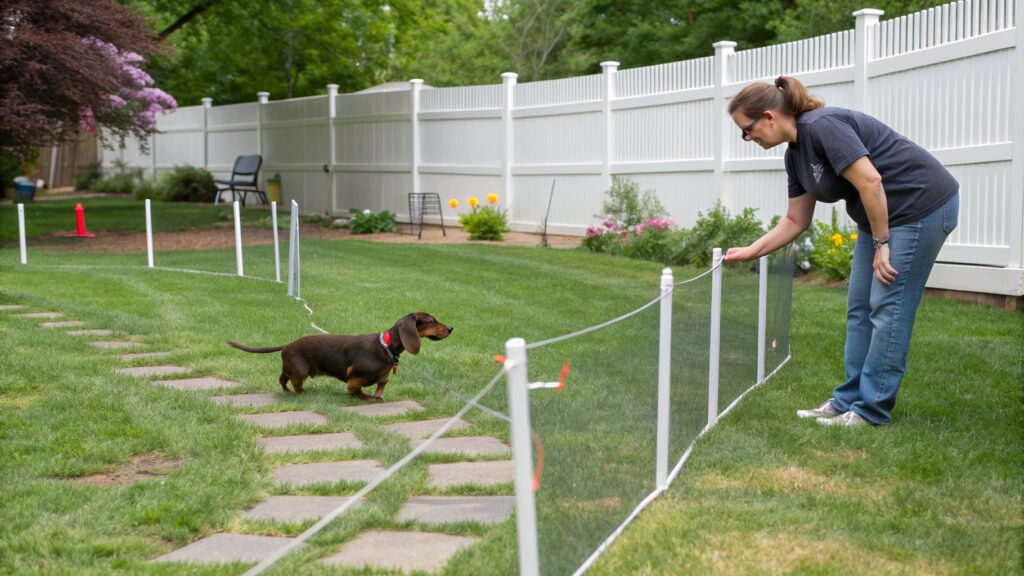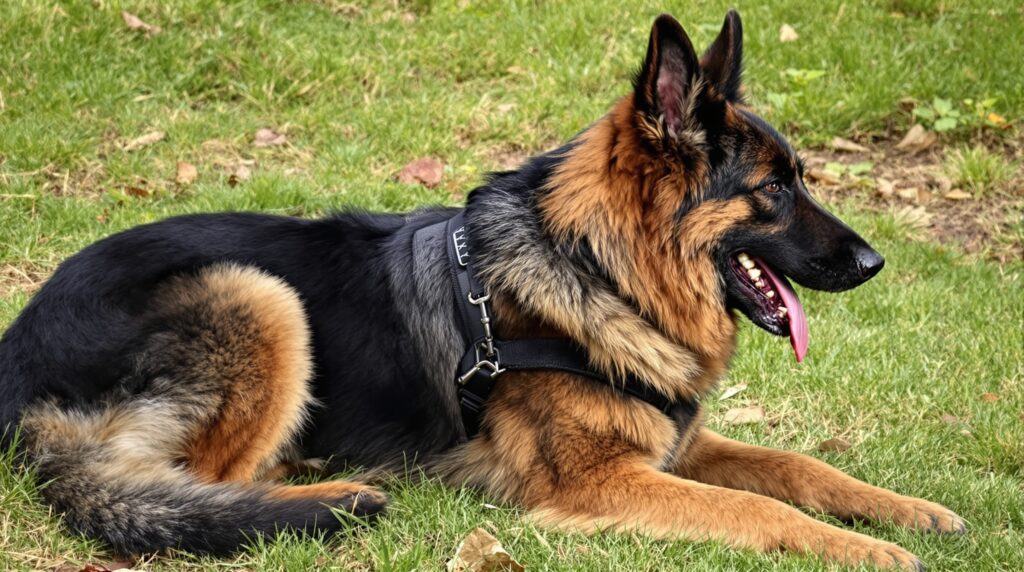Training a Dachshund really takes patience, structure, and a plan you can stick to. These dogs are clever and full of personality, but they’ll push boundaries if you don’t set clear rules early on.
Firm boundaries give them the guidance they need to feel secure and behave well at home.
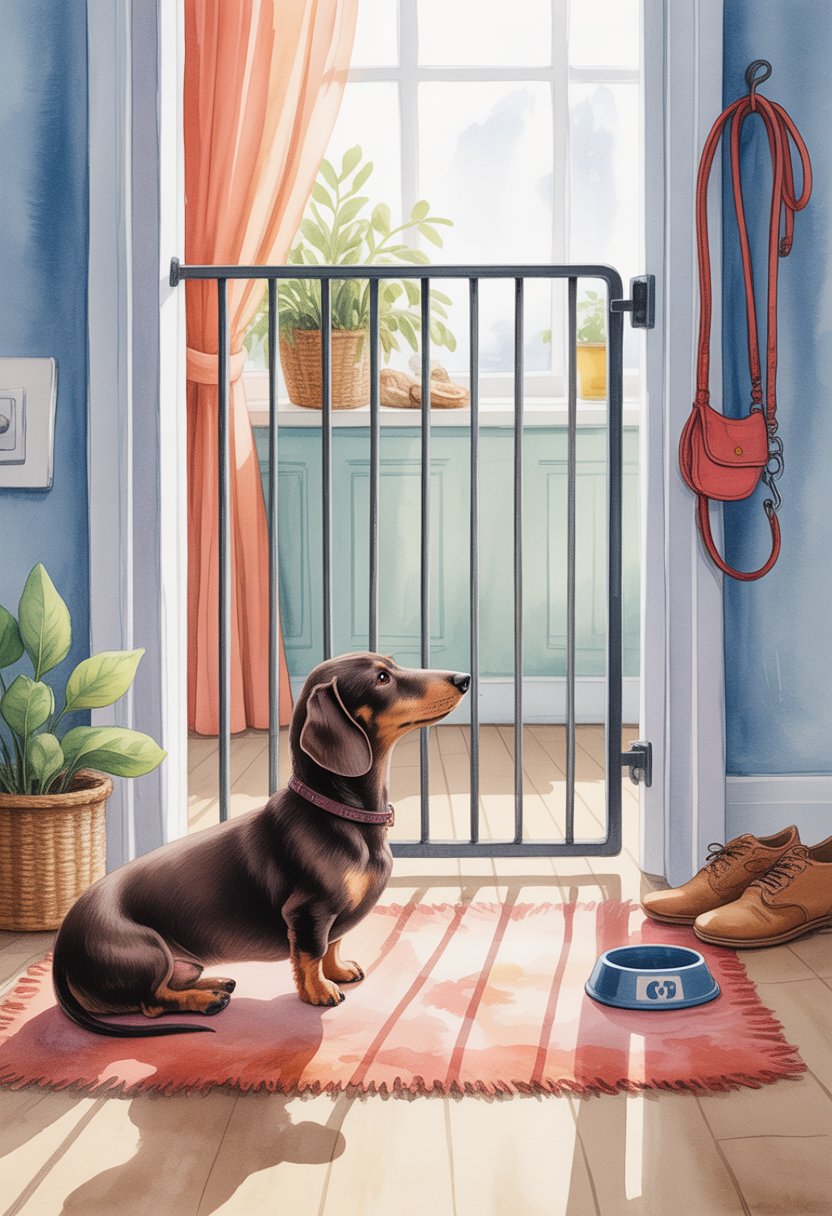
Simple rules shape daily routines and steer behavior. They also help avoid common headaches like barking, chewing, or digging.
Set limits in a steady, positive way and you’ll help your Dachshund grow into a well-mannered companion. It’s not always easy, but it’s worth it.
Set consistent daily routines for feeding and walks
A dachshund feels more secure when the daily routine stays predictable. Feeding at the same times each day helps the dog know what to expect and cuts down on begging or restlessness.
Predictable meal times also support healthy digestion. Regular walks at set times give structure and help manage energy.
Scheduled walks let the dachshund know when to expect bathroom breaks, which really helps with house training. Even if the exact time shifts a bit, sticking to a familiar pattern matters most.
A steady order of feeding and walking helps the dog feel safe and cared for. It’s the pattern, not the clock, that counts.
Use a designated spot for your Dachshund to rest
A Dachshund feels more at ease when it knows exactly where to relax. Giving your dog a set place—like a bed or mat—helps it understand boundaries at home.
This keeps the dog from taking over furniture or constantly changing spots. The resting spot should be comfy and quiet.
A soft mat, crate, or dog bed works well. When the dog always gets guided to the same place, it’ll start picking it on its own.
Over time, this space becomes safe and familiar. It also makes it easier to manage energy and stick to routines.
A clear spot for downtime helps balance play, training, and sleep. Sometimes, just having a cozy corner makes all the difference.
Establish clear ‘no’ zones, like furniture or certain rooms
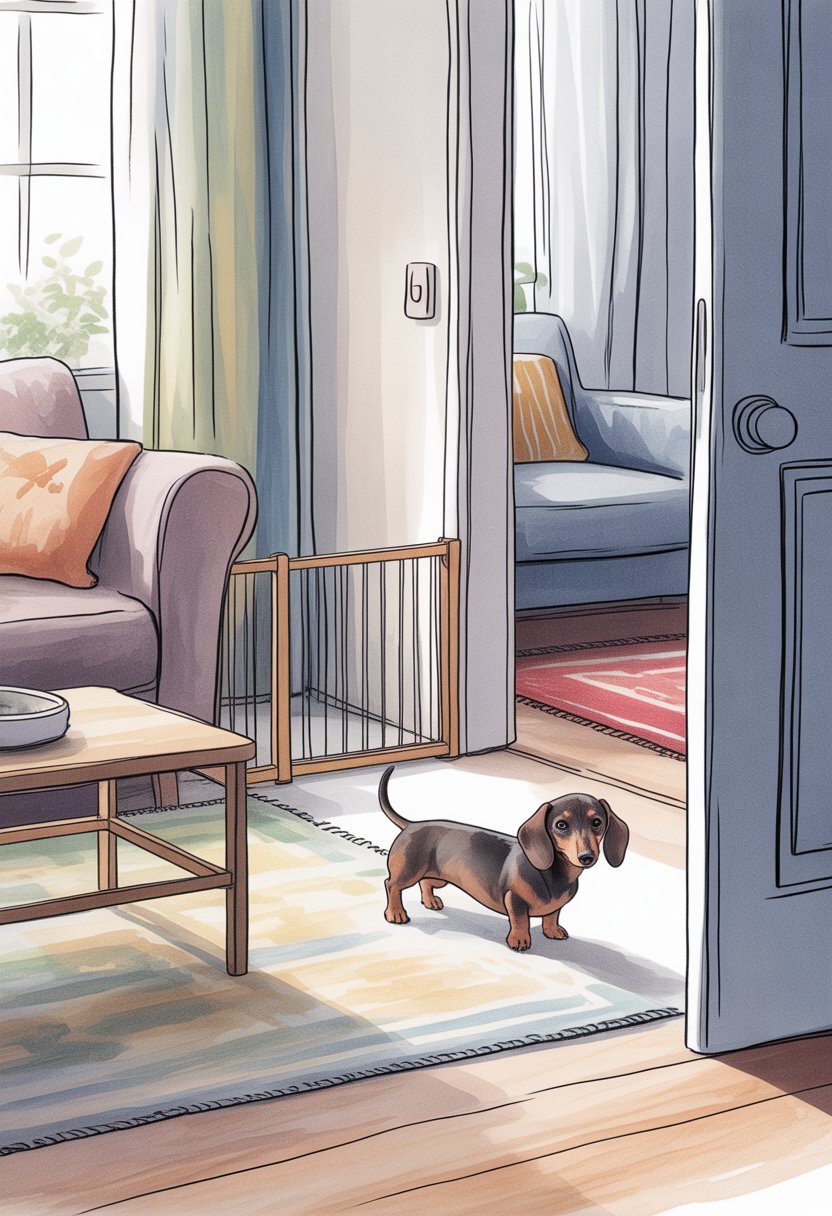
A dachshund does better when it knows which areas are off-limits. Clear “no” zones prevent confusion and keep things organized at home.
These zones might include furniture, bedrooms, or any spaces you want to keep pet-free. Use gates, closed doors, or furniture covers to mark these boundaries.
Stick to the same rules every day. If the couch is off-limits, it should always be off-limits.
Creating no-go areas also keeps your dog safe. For example, blocking the kitchen lowers the risk of accidents with hot food or sharp objects.
Limiting access to stairs helps prevent injuries, since dachshunds’ long backs are prone to strain. Positive reinforcement makes these zones easier to teach.
Reward your dog for staying in approved spaces so they catch on faster. Over time, they’ll know exactly where they’re welcome.
Implement a firm ‘sit’ command before meals or walks
Teaching your dachshund to sit before meals or walks sets a clear expectation. It shows the dog that calm behavior leads to good things, like food or going outside.
This simple step builds structure into your daily routine. When the dog learns to sit and wait, it prevents pushy or impatient behavior.
Instead of jumping or barking, the dog learns to focus and wait for your signal. Mealtimes and walks become more relaxed for everyone.
Ask for a sit every time before the bowl goes down or the leash goes on. Over time, this becomes a habit that takes little correction.
Use praise or a small treat after your dog sits. Positive reinforcement makes the command rewarding and encourages them to repeat it.
Simple, steady practice keeps the boundary firm. This rule also teaches patience, helping your dachshund manage excitement and giving you better control.
Redirect digging behavior with approved toys
Dachshunds dig because it’s part of their natural instinct. They were bred to hunt underground, so the urge is strong.
Instead of punishing digging, guide it in a better direction. Give your dog approved toys to channel energy.
Puzzle toys, chew toys, or treat-dispensing toys can keep them busy. This helps shift focus from the yard to more positive activities.
Try interactive play, like tug or fetch, to burn energy and strengthen your bond. When a dachshund feels engaged, digging often drops off.
Some owners set up a designated digging spot, like a sandbox filled with safe materials. Hide toys or treats there to encourage digging in the right place.
When your dog leaves a digging spot and redirects to play, give praise and a toy. With patience and consistency, you can turn that digging habit into something manageable.
Use positive reinforcement immediately after obeying commands

When a Dachshund follows a command, reward them right away. This helps the dog connect the action with the good outcome.
Waiting too long just confuses things. Rewards can be small treats, gentle praise, or a favorite toy.
The key is to use something your dog actually values. Over time, they’ll learn that listening brings good results.
If you reward your dog every time it obeys, the behavior gets stronger. Skipping rewards or giving them too late makes progress slower.
Positive reinforcement builds trust, too. The dog feels encouraged and more eager to repeat the behavior.
By rewarding right after the correct action, Dachshunds understand exactly what you want. This timing makes learning clear, simple, and honestly, a lot more fun.
Avoid giving in to barking by ignoring attention-seeking behavior

When a dachshund barks for attention, it’s tempting to respond. Even scolding or telling them to stop still gives them what they want—your attention.
Ignoring the barking teaches your dog that this behavior won’t get them anywhere. Over time, they’ll realize staying calm and quiet is the better way to get noticed.
Wait until the barking stops before giving praise or attention. This shows the dachshund that quiet behavior earns a reward.
If you sometimes give attention for barking and sometimes don’t, the behavior might stick around. Clear, steady rules help your dachshund understand what you expect.
Providing toys or activities can also help cut down on attention-seeking barking. When your dog has something else to focus on, they’re less likely to bark just to get noticed.
Set limits on playtime to prevent overexcitement

Dachshunds love play, but too much excitement can quickly turn into barking, nipping, or ignoring commands. Setting clear limits on play keeps them calm and responsive.
Short play sessions work best for this breed. A few minutes of fetch or tug is usually enough before they need a break.
Stopping play before your dog gets too wound up teaches self-control. Owners can use simple cues, like “all done,” to signal the end of play.
Over time, the dog learns that play has a clear start and finish. This makes it easier for them to settle down afterward.
Consistent limits also protect your dachshund’s health. Their long backs can get strained if they play too hard or too long.
Controlled play keeps them safe while still letting them burn energy. By setting boundaries, you guide your dachshund toward calmer behavior.
They learn that fun comes with structure, which helps everyone enjoy playtime more.
Understanding Dachshund Behavior
Dachshunds are clever but strong-willed dogs who love to test limits. They really do best with structure, patience, and clear expectations—not harsh methods.
Why Boundaries Matter for Dachshunds
Dachshunds started out as hunting dogs, so they’re naturally independent and a bit stubborn. If you don’t set rules, they’ll often try to run the show at home.
Boundaries give these little dogs a sense of security. They help cut down on annoying habits like barking or guarding.
Clear limits keep things less confusing. Let’s say you sometimes let your Dachshund on the furniture, but other times you don’t—well, that just leaves them guessing.
Consistency actually helps them feel safer and makes it easier for them to follow your lead.
When you guide their behavior with treats, praise, or even a quick game, your Dachshund starts to connect good actions with good things. That’s how you build cooperation, not just obedience.
Routines make setting boundaries way easier. Feed them at the same time each day, stick to a walk schedule, and give them a dedicated spot to rest.
These simple habits take the edge off their stress and help them learn faster.
Common Behavioral Challenges
Dachshunds are known for their stubborn streak. Training can drag on if they pick up on any inconsistency.
Patience and repetition—yep, you’ll need plenty—are what keep them interested.
Barking is a classic Dachshund move. Thanks to their hunting roots, they’re quick to sound the alarm at any noise.
Teaching a “quiet” command and rewarding calm moments can make a big difference.
Separation anxiety crops up a lot, too. These dogs bond hard and get upset when left alone.
A cozy spot with toys or calming aids sometimes helps them settle down.
Digging is in their DNA. They love to burrow and can get destructive if bored.
Puzzle toys, chews, or supervised play sessions help channel that energy. Setting clear boundaries and redirection keep these habits from getting out of hand.
Consistency and Positive Reinforcement
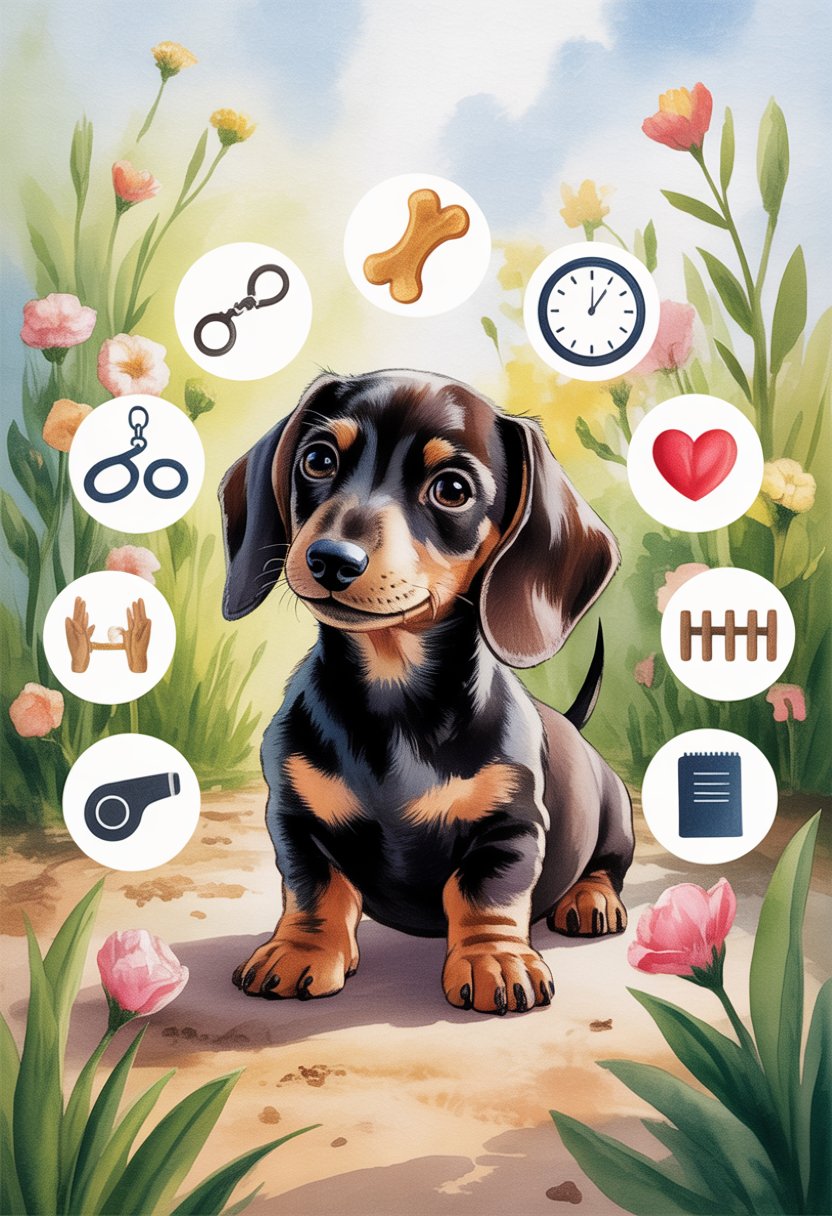
Dachshunds pick things up best when training feels predictable and rewarding. If you keep routines and give lots of positive feedback, they start to get what you want and repeat the good stuff.
Establishing a Routine
A Dachshund really thrives when life sticks to a pattern. Feeding, bathroom breaks, and training at set times each day give their day structure and cut down on confusion.
Stick with the same commands and hand signals for each behavior. If you change up your words or gestures, progress slows and your dog gets frustrated.
Short, regular training sessions work way better than long, random ones. Two or three 10-minute sessions a day keep their attention without overloading them.
Consistency with rules matters, too. If the couch is off-limits, everyone in the house needs to stick to that rule.
Otherwise, mixed messages just leave your Dachshund confused about what’s actually allowed.
Reward-Based Training Techniques
Positive reinforcement works wonders with Dachshunds. Treats, praise, and play all motivate them—especially since most are food-driven and just love attention.
Timing is key. Give the reward right after the good behavior so your dog connects the dots. Wait too long, and you’ll probably just confuse them.
Mix up the rewards to keep things fresh. For instance:
- Small treats for quick commands like “sit.”
- Verbal praise when they’re calm indoors.
- Playtime after longer tasks or recall practice.
Don’t go overboard with treats, though. Use tiny, healthy ones or even a bit of their regular food to avoid packing on extra pounds.

